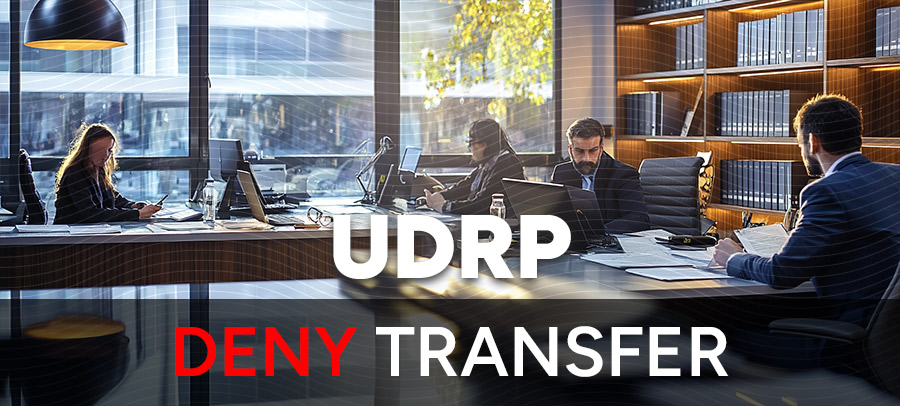Brazilian auto parts giant Iochpe-Maxion S/A filed a UDRP complaint to acquire Maxion.com, citing trademarks dating back to 1991 and longstanding global use of the MAXION brand. The domain, originally registered in 2000, was acquired by a domain investor in 2017 for $2,605 via a NameJet auction.
Represented by domain attorney John Berryhill, the Respondent argued that “Maxion” is a common surname with widespread commercial use, citing dozens of unrelated companies using the same name across various industries, none affiliated with the Complainant and emphasized his broader investment in surname-based domains.
The Complainant cited media coverage, industry awards, and previous attempts to buy the domain, including a $7,000 offer allegedly countered with a $115,000 asking price. The three member WIPO Panel found no proof that the Respondent acquired the domain to target the Complainant or capitalize on its mark.
Final decision: Deny the transfer of Maxion.com to the Complainant.

Copyright © 2025 DomainGang.com · All Rights Reserved.ARBITRATION AND MEDIATION CENTER – ADMINISTRATIVE PANEL DECISION
Iochpe-Maxion S/A v. Myles Hare, URL Enterprises Ltd
Case No. D2025-18741. The Parties
The Complainant is Iochpe-Maxion S/A, Brazil, represented by MacMillan, Sobanski & Todd, LLC, United States of America (“United States”).
The Respondent is Myles Hare, URL Enterprises Ltd, Canada, represented by John Berryhill, Ph.d., Esq., United States.
2. The Domain Name and Registrar
The disputed domain name maxion.com is registered with GoDaddy Online Services Cayman Islands Ltd. (the “Registrar”).
3. Procedural History
The Complaint was filed with the WIPO Arbitration and Mediation Center (the “Center”) on May 10, 2025. On May 12, 2025, the Center transmitted by email to the Registrar a request for registrar verification in connection with the disputed domain name. On May 12, 2025, the Registrar transmitted by email to the Center its verification response disclosing registrant and contact information for the disputed domain name which differed from the named Respondent (Domains By Proxy, LLC) and contact information in the Complaint. The Center sent an email communication to the Complainant on May 13, 2025, providing the registrant and contact information disclosed by the Registrar, and inviting the Complainant to submit an amendment to the Complaint. The Complainant filed an amended Complaint on May 18, 2025.
The Center verified that the Complaint together with the amended Complaint satisfied the formal requirements of the Uniform Domain Name Dispute Resolution Policy (the “Policy” or “UDRP”), the Rules for Uniform Domain Name Dispute Resolution Policy (the “Rules”), and the WIPO Supplemental Rules for Uniform Domain Name Dispute Resolution Policy (the “Supplemental Rules”).
In accordance with the Rules, paragraphs 2 and 4, the Center formally notified the Respondent of the Complaint, and the proceedings commenced on May 21, 2025. In accordance with the Rules, paragraph 5, the due date for Response was June 10, 2025, however, following a request by the Respondent, this was automatically extended under paragraph 5(b) of the Rules to June 14, 2025. The Response was filed with the Center on June 13, 2025.
On July 9, 2025, the Complainant requested permission to file an unsolicited supplemental filing and included with the request the proposed substantive supplemental filing.The Center appointed Warwick A. Rothnie, Alan L. Limbury, and Evan D. Brown as the panelists in this matter on July 11, 2025. The Panel finds that it was properly constituted. The Panel has submitted the Statement of Acceptance and Declaration of Impartiality and Independence, as required by the Center to ensure compliance with the Rules, paragraph 7.
4. Factual Background
The Complainant is a corporation formed under the laws of Brazil which, according to the Complainant, since 1989 has been manufacturing and distributing a range of goods and services which, in addition to vehicle wheels, the Complainant summarizes as including “structural vehicle parts and components, metallurgical products, tools and instruments, and retail sales, leasing, and exports”.
Annex 19 to the Complainant’s unsolicited supplemental filing includes five press articles from Germany, India, the United Kingdom, and the United States reporting on business developments or promoting a product – under the names “Maxion”, “Maxion Wheels”, and “Maxion Bionic”. The Annex also includes 12 awards or other marks of customer recognition from businesses including Mercedes Benz, Wabash, Nissan, Kaizen, Honda, Kia and Ford. These appear to be awarded to “Maxion Wheels”.
According to the Complainant’s unsolicited supplemental filing, the Complainant holds 25 domain names based on “maxion”. It is not clear from the Complaint, or the unsolicited supplemental filing, which of these are in use, although a Google search by the Panel1 discloses as the second organic search result a listing for the website at “www.maxionwheels.com”.
1 With reference to the Panel conducting independent research, see the WIPO Overview of WIPO Panel Views on Selected UDRP Questions, Third Edition, (“WIPO Overview 3.0”), section 4.8.Annex 4 to the Complaint includes a table indicating the Complainant holds registered trademarks in many jurisdictions around the world. Some of these are for MAXION; others are for a figurative device:
(in some cases, the registration is in black and white). For present purposes, it is sufficient to note that the earliest registrations date from 1991 and 1992 in Brazil: Registered Trademark No. 814854036, MAXION, which has been registered since May 21, 1991, in respect of flat and non-flat metallurgical products; electrode and filler metals for welding; molds and taps for metal casting, all included in International Class 6. There is also a Brazilian Registered Trademark No. 200073346 for MAXION, which has been registered since August 20, 1991, in respect of tools, instruments, hardware, sandpaper, grinding wheels, and abrasives included in International Class 8. The Complaint includes details of registered trademarks in Brazil covering several other classes. In addition, the Panel notes that the Complainant also draws particular attention to:
(a) United States Registered Trademark No. 3,600,899, MAXION, which has been registered since April 7, 2009, in respect of land vehicles parts, namely, wheels, chassis, longerons, stingers; pressed parts and drop forged parts, namely, structural parts for trucks, buses, vans, tractors and off-road vehicles in International Class 12. This registration claims first use in commerce in the United States in 1993; and
(b) United States Registered Trademark No 4,530,135, MAXION (design), which has been registered since May 13, 2014, in respect of land vehicles parts, namely, wheels, chassis, longerons, stingers; pressed parts and drop forged parts, namely, structural parts for trucks, buses, vans, tractors and off-road vehicles in International Class 12. This registration claims first use in commerce in the United States on February 20, 2023.
The disputed domain name was registered on March 10, 2000. However, it does not appear to be in dispute that the Respondent first acquired the disputed domain name through an auction process on April 17, 2017, for a price of USD 2,605, following which, the disputed domain name resolved to a website at which the disputed domain name was offered for sale.
According to email reports from an intermediary engaged by the Complainant for the purpose, the Complainant made an offer to acquire the disputed domain name for USD 7,000 in July 2019. According to the intermediary’s report, this offer was rejected and a price of at least USD 115,000 was nominated.
The Complainant’s unsolicited supplemental filing includes evidence that the Complainant made a further attempt to buy the disputed domain name in July 2024 using Network Solutions’ Certified Offer service. The amount of the offer has been redacted. It too was unsuccessful.
5. Discussion and Findings
Paragraph 4(a) of the Policy provides that in order to divest the Respondent of a disputed domain name, the Complainant must demonstrate each of the following:
(i) the disputed domain name is identical or confusingly similar to a trademark or service mark in which the Complainant has rights;
(ii) the Respondent has no rights or legitimate interests in respect of the disputed domain name; and
(iii) the disputed domain name has been registered and is being used in bad faith.
Paragraph 15(a) of the Rules directs the Panel to decide the Complaint on the basis of the statements and documents submitted and in accordance with the Policy, these Rules and any rules and principles of law that it deems applicable.
A. Unsolicited supplemental filing
Apart from documents requested by the Panel pursuant to paragraph 12 of the Rules, neither the Policy nor the Rules expressly provide for supplemental filings. Their admissibility is therefore in the discretion of the Panel bearing in mind the requirements under paragraph 10 of the Rules to ensure that the proceeding is conducted with due expedition and both parties are treated equally, with each party being given a fair opportunity to present its case.
The proposed supplemental filing addresses a number of issues. First, it disputes claims in the Response that some allegations made in the Complaint are unsupported by evidence and seeks to identify the supporting evidence.
Secondly, it addresses some claims in the Response which it says the Complainant could not reasonably anticipate. These include the Respondent’s claims that “Maxion” is a common surname and there are several other owners of registered trademarks for MAXION; the details of the Complainant’s prior attempts to purchase the disputed domain name from the Respondent, other evidence of bad faith and evidence supporting the Complainant’s claim that the Respondent has engaged in a pattern of abusive domain name registrations.
Some of these matters, at least, can and should have been addressed fully in the Complaint. For example, the details of the Complainant’s prior attempts to buy the disputed domain name and the evidence supporting the allegations that the Respondent had engaged in a pattern of abusive registrations.
In the interests of dealing with the substance of the Complaint, however, the Panel considers it appropriate to admit the unsolicited supplemental filing into the record. Given the view the Panel takes of the case, it is unnecessary to put the Parties to further expense in this proceeding by inviting the Respondent to reply to the unsolicited supplemental filing.B. Identical or Confusingly Similar
The first element that the Complainant must establish is that the disputed domain name is identical or confusingly similar to the Complainant’s trademark.
It is well accepted that the first element functions primarily as a standing requirement. The standing (or threshold) test for confusing similarity involves a reasoned but relatively straightforward comparison between the Complainant’s trademark and the disputed domain name. WIPO Overview 3.0, section 1.7. The comparison of the disputed domain name to the Complainant’s trademark simply requires a visual and aural comparison of the disputed domain name to the proven trademarks.
It is not in dispute between the Parties that the disputed domain name is identical to the Complainant’s trademark and the requirement under the first limb of the Policy is satisfied.
C. Rights or Legitimate Interests
The second requirement the Complainant must prove is that the Respondent has no rights or legitimate interests in the disputed domain name.
Paragraph 4(c) of the Policy provides that the following circumstances can be situations in which the Respondent has rights or legitimate interests in a disputed domain name:
(i) before any notice to [the Respondent] of the dispute, [the Respondent’s] use of, or demonstrable preparations to use, the [disputed] domain name or a name corresponding to the [disputed] domain name in connection with a bona fide offering of goods or services; or
(ii) [the Respondent] (as an individual, business, or other organization) has been commonly known by the [disputed] domain name, even if [the Respondent] has acquired no trademark or service mark rights; or
(iii) [the Respondent] is making a legitimate noncommercial or fair use of the [disputed] domain name, without intent for commercial gain to misleadingly divert consumers or to tarnish the trademark or service mark at issue.
These are illustrative only and are not an exhaustive listing of the situations in which a respondent can show rights or legitimate interests in a domain name.
While the overall burden of proof in UDRP proceedings is on the complainant, panels have recognized that proving a respondent lacks rights or legitimate interests in a domain name may result in the often impossible task of “proving a negative”, requiring information that is often primarily within the knowledge or control of the respondent. As such, where a complainant makes out a prima facie case that the respondent lacks rights or legitimate interests, the burden of production on this element shifts to the respondent to come forward with relevant evidence demonstrating rights or legitimate interests in the domain name. If the respondent fails to come forward with such relevant evidence, the complainant is deemed to have satisfied the second element. WIPO Overview 3.0, section 2.1.
There is no dispute between the Parties that:
(1) The Respondent registered the disputed domain name after the Complainant began using the trademark and also after the Complainant had registered its trademark;
(2) The Respondent is not affiliated with the Complainant;
(3) The Complainant has not otherwise authorised the Respondent to use the disputed domain name;
(4) The disputed domain name is not derived from the Respondent’s name. Nor is there any suggestion of some other name by which the Respondent is commonly known from which the disputed domain name could be derived.
These factors are usually sufficient to establish a prima case that the Respondent does not have rights or legitimate interests in a disputed domain name.
The Respondent denies registering the disputed domain name with knowledge of the Complainant. Instead, the Respondent says he has a portfolio of domain names which are, or are based on, surnames. The Respondent points out that before he acquired the disputed domain name it was held by a company known as Maxion Technologies Inc., a manufacturer of LEDs. In addition to that company, the Respondent has identified a number of other owners of registered trademarks for MAXION and businesses which have registered or are using domain names formed on “maxion”. These include:
(a) Maxion Therapeutics, which holds maxiontherapeutics.com and maxion.co.uk;
(b) “www.maxion.tech” – a gaming technology startup;
(c) “www.maxion.de” – an industrial manufacturing equipment company;
(d) “www.themaxion.com” – home of the Maxion dating app;
(e) “www.maxion.ca” – a Canadian real estate development company;
(f) “www.maxion.co.nz” – a New Zealand business providing office support services for the MAXION® group of companies which, from the website, appears to provide a range of construction, equipment rental and other services;
(g) “www.maxion.com.au” – an Australian real estate concern;
(h) “www.maxion.fi” – Maxion Oy, a Finnish electronic technology company;
(i) “www.maxionresearch.com” – a consumer research agency;
(j) “www.maxioncorp.com” – Maxion Electronic Co, Ltd. a longstanding LED company;
(k) “www.maxiondesign.com” – Maxion Design, a California architectural firm;
(l) “www.maxionnutrition.com” – a Canadian vitamin and supplement company.
The registered trademarks identified by the Respondent (apart from those of the Complainant) are held by Kaz Europe Sarl of Switzerland for water filter apparatus; Bruno Martins Soares; Concurrent Computer Corporation; Ion Beam Services SA; Ion G.K.N. International Limited; K. Ganesan; Manish Kumar Lohani; Maxion Group Limited; Maxion Jansche & Ortlepp GmbH; Maxion Therapeutics Limited; Natural Equivalent Inc; and Sankonfort Colchoes Industria E Comercio Ltda.
According to the Response:
“The Respondent reasonably believes this word [‘maxion’] to have commercial value as a nonexclusive surname independent of the Complainant. The larger context renders it clear that (a) Respondent has a relevant history and pattern of registration and dealing in surname domain names, (b) the Respondent has never used the domain name in any manner targeting the Complainant’s limited trademark rights, and (c) the Respondent has never attempted to sell the domain name to the Complainant.”
The Panel notes that the Respondent has successfully defended two prior complaints where the Respondent was found to have registered domain names on the basis they constituted common acronyms.
The Complainant disputes that the Respondent can claim rights or legitimate interests on the basis outlined. First, the Complainant points out that the number of people with the surname Maxion is “vanishingly small” with only 160 people out of the United States’ 300 million population having that birth name. The Complainant also contends that the Respondent has no connection to the name “Maxion” and has provided no evidence of any use of it, or plans to use it, in connection with “Maxion” as a surname. Thirdly, the Complainant seeks to rebut the claimed legitimate use by pointing to a Reverse WhoIs search showing the Respondent has also registered numerous domain names which appear to be replicate third parties’ trademark and giving by way of example from the letter “a”:
– abalorio.com;
– abercrombies.com;
– ableenergy.com;
– affinis.com, and;
– apexmotors.com.
all of which resolve to pages offering them for sale.
In the circumstances of this case, the Panel considers it appropriate to consider the question of the Respondent’s good faith or otherwise in the context of the third requirement: whether or not the disputed domain name has been registered in bad faith and subsequently used in bad faith.
D. Registered and Used in Bad Faith
Under the third requirement of the Policy, the Complainant must establish that the disputed domain name has been both registered and used in bad faith by the Respondent. These are conjunctive requirements; both must be satisfied for a successful complaint: see e.g. Group One Holdings Pte Ltd v. Steven Hafto WIPO Case No. D2017-0183.
Generally speaking, a finding that a domain name has been registered and is being used in bad faith requires an inference to be drawn that the respondent in question has registered and is using the disputed domain name to take advantage of its significance as a trademark owned by (usually) the complainant.
As already noted, the Respondent denies knowledge of the Complainant and its trademark. The Complainant disputes this claim, pointing to the offer to sell the disputed domain name for USD 115,000 while rejecting an offer of USD 7,000 when the Respondent acquired the disputed domain name for USD 2,605 and the “list price” of a similar, available domain name – maxion.biz is USD 1.99.
According to the Complainant (in the context of rights and legitimate interests):
“Notwithstanding these other trademark and domain name owners, Complainant asserts that, due to its long-term use of the MAXION trademark starting at least as early as 1989 and ongoing continuously to the present day, the public generally recognizes MAXION as referring to Complainant. This public recognition is reflected in the pieces of unsolicited media coverage of Complainant’s MAXION products, as well as various awards therefor, in the US and other countries, several of which are attached hereto as Annex 19. Further, Complainant itself owns 25 MAXION formative domain names, as listed on Annex 20 hereto. This evidence makes it clear that when the public sees the term MAXION, they associate it first with Complainant.”
The Panel is mindful that the Respondent has not admitted that it did offer to sell the disputed domain name for USD 115,000; the evidence in support is an email report by the Complainant’s agent.
Nonetheless, the evidence before the Panel (including that submitted in the Complainant’s unsolicited supplemental filing) falls well short of establishing that the Complainant is so well-known that the public necessarily associates MAXION with the Complainant and that the Respondent recognised this when he registered the disputed domain name.
It is of course possible that the Respondent did know of the Complainant and its trademark when acquiring the registration of the disputed domain name but, given the range of other businesses using “Maxion” at least and the evidence before the Panel, that is not a conclusion the Panel can confidently draw in the face of the Respondent’s denial.
Equally, assuming in the Complainant’s favour that the Respondent did offer to sell the disputed domain name for USD 115,000, that does not mean the Respondent must have had the Complainant in mind when acquiring the registration of the disputed domain name. The amount asked for is suggestive of an awareness that the term “Maxion” has trademark significance. Given the number of other businesses apparently using “Maxion”, however, whether the amount was predicated on knowledge of the Complainant, or one of the other businesses or even just the potential for competition between them, does not avail the Complainant. First, the exchange did not take place until almost two years after the Respondent acquired the registration. Secondly, as the Policy is currently being interpreted and applied, a finding of bad faith registration and use under the Policy requires a finding that the Respondent has targeted the Complainant specifically at both the stage of registration and subsequent use.
The record in this case does not enable to the Panel to reach those conclusions.
7. Decision
For the foregoing reasons, the Complaint is denied.
Warwick A Rothnie
Presiding PanelistAlan Limbury
Panelist/Evan Brown/
Evan Brown
Panelist
Date: July 25, 2025










